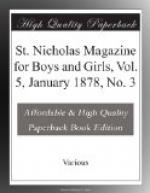Nippenose, Eau Gallie, Need
More, Kandiyohi, Nobob, Cob Moo Sa, We
Wo Ka, Ty Ty, Osakis, Why Not, Happy Jack, U Bet, Choptack,
Fussville, Good Thunder’s Ford, Apopka, Burnt Ordinary, Crum Elbow,
Busti, Cheektowaga, Yuba Dam, Dycusburgh, Chuckatuck, Ni Wot, Buck
Snort, What Cheer, Forks of Little Sandy, Towash, Sopchoppy, Thiry
Daems, Vicar’s Switch, Omph Ghent, Peculiar.
Wo Ka, Ty Ty, Osakis, Why Not, Happy Jack, U Bet, Choptack,
Fussville, Good Thunder’s Ford, Apopka, Burnt Ordinary, Crum Elbow,
Busti, Cheektowaga, Yuba Dam, Dycusburgh, Chuckatuck, Ni Wot, Buck
Snort, What Cheer, Forks of Little Sandy, Towash, Sopchoppy, Thiry
Daems, Vicar’s Switch, Omph Ghent, Peculiar.
I have found a great many
more, but these are the queerest I could
pick out.—Yours
truly,
WILLIAM B.
ANSWERS TO RIDDLES.
Here are two answers, out of the three, to the riddles I gave you last month: TOBACCO, and CARES (Caress). The archbishop’s puzzle has been too much for you, I’m afraid, my dears. I’ll give you until next month. Then we’ll see.
THE LETTER-BOX.
Washington, D.C.
DEAR ST. NICHOLAS: Not long ago I read in your delightful magazine a poem, entitled “Red Riding Hood,” by John G. Whittier. It recalled to me some visits which I made to the great and good poet, my friend of many years.
My acquaintance with him began
when I was a school-girl in Salem.
Then he lived in Amesbury,
on the “shining Merrimack,” as he calls
it, with his sister, a most
beautiful and lovable person.
I remember distinctly my first visit to them. The little white house, with green blinds, on Friend street, looked very quiet and home-like, and when I received the warm welcome of the poet and his sister I felt that peace dwelt there. At one side of the house there was a little vine-wreathed porch, upon which opened the glass-door of the “garden room,” the poet’s favorite sitting room, the windows of which looked out upon a pleasant, old-fashioned garden. Against the walls were books and some pictures, among which were “Whittier’s Birthplace in Haverhill,” and “The Barefoot Boy,” the latter illustrating the sweet little poem of that name.
In the parlor hung a picture of the loved and cherished mother, who had died some years before, a lovely, aged face, full of strength and sweet repose. In a case were some specimens of the bird referred to in “The Cry of a Lost Soul,” a poem which so pleased the Emperor of Brazil that he sent these birds to the poet.
At the head of the staircase hung a pictured cluster of pansies, painted by a lady, a friend of the poet. He called my attention to their wonderful resemblance to human faces. In the chamber assigned to me hung a large portrait of Whittier, painted in his youth. It was just as I had heard him described in my childhood. There were the clustering curls, the smooth brow, the brilliant dark eyes, the firm, resolute mouth.
We spent a very pleasant evening in the little garden room, in quiet, cheerful conversation.




